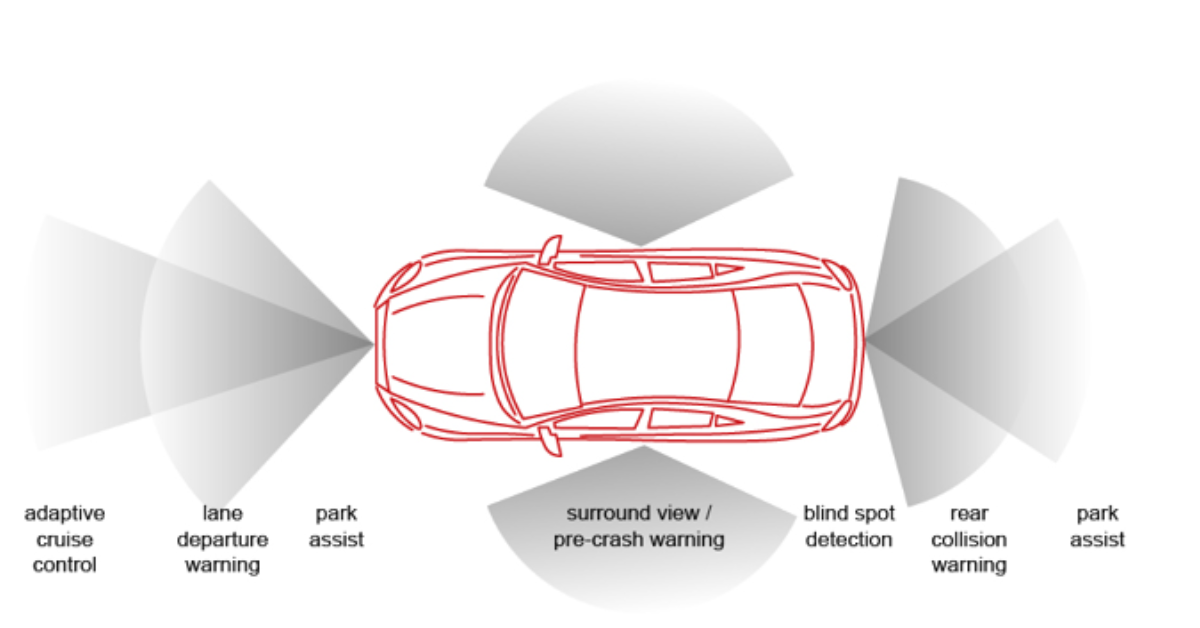Introduction
The ADAS systems use advanced technologies to assist the driver during driving and thereby improved the driver’s performance. It used sensors in the vehicles such as radar and cameras to perceive the world around it and then provides information to the driver or takes automatic based on what it perceives. The modernization of ADAS applications is the first step toward realizing autonomous vehicles.
How does the ADAS system work?
Self-driving cars use a variety of technologies to gain 360-degree vision of both near and far. The ADAS system works consists of sensors various chips and systems on a chip interface and a powerful computer processor that integrates all of the data and makes a decision in real-time.
The implementation of cameras in the vehicle involves a new AL function that uses sensor fusion to identify and process objects. Sensor fusion is similar to how the human brain process information it combines large amounts of data with the help of image recognition software ultrasound sensors lidar and radar. This technology can physically respond faster than a human driver ever could.
The ADAS-equipped vehicles have an array of advanced sensors that augment the eyes ears and decision-making of the human driver.
You can also read: Solar car advantages
ADAS levels:
Advanced driver assistance system levels are technical features that are intended to improve vehicle safety they are categorized into different levels based on the amount of automation and the scale provided by the society of automotive engineers. The ADAS system work can be divided into six levels.
Level 0:
In level 0 the driver is entirely responsible for managing the vehicle including steering, braking, accelerating, and slowing down.
Level 1:
In level 1 the vehicle has at least one driver support system that assists in for example adaptive cruise control which maintains the following distance behind traffic ahead without intervention from the driver.
Level 2:
In level 2 the vehicle can perform steering and acceleration the driver still monitors all tasks and can take control at any time.
Level 3:
A level 3-ready autonomous vehicle is capable of driving itself in particular conditions during which it will take control of all safety-critical systems. Nonetheless, when the system asks it the driver is supposed to take control.
Level 4:
In level 4 you can take an app while riding in the vehicle. Level 4 driving automation technology is for use in driverless taxis in public transportation services. Such vehicles will be programmed to travel between point A to point B and restricted to specific geographic boundaries by Geo-fencing technology.
Level 5:
In level 5 the vehicle performs all driving tasks under all conditions. At this level, zero human attention or interaction is required.
ADAS systems:
Adaptive cruise control:
Adaptive cruise control is designed to help road vehicles maintain the following distance and stay within the speed limit. This system automatically adjusts to the car’s speed so drivers don’t have advanced cruise control and can automatically accelerate slow down and sometimes stop the vehicle depending on the actions of other objects in the immediate area. It is constructive on the highway where drivers can find it challenging to monitor their speed and other cars over a long period.
Cross-wind stabilization:
Cross-wind assist detects track offset caused by strong crosswinds on time and thus helps the driver to remain in their lane a sudden track offset of the vehicle can cause some proper steering reactions of the driver that’s why crosswind assist automatically corrects the vehicle’s course from a speed of 50 miles per hour. This system distributes the wheel load to the velocity and direction of the crosswind and it was first featured in a 2009 Mercedes-Benz S-class.
Traction control system:
A traction control system helps prevent traction loss in vehicles and prevent vehicle turnover on sharp curves and turns. The TCS system detects if a loss of traction occurs among the car’s wheels and automatically applies the brakes to that individual or cuts down the car’s engine power to the slipping wheel. These systems use the same wheel speed sensors as the anti-lock braking system. Individual wheel braking systems are deployed through TCS to control when one tire spins faster than the others.
Electronic stability control:
It helps prevent loss of control in curves and emergency steering Maneuvers by stabilizing your car when it begins to veer off your intended path. The electronic stability control system can lessen the car’s speed and activate individual brakes to prevent understeer and oversteer. In simple words, it works automatically to help the driver maintain control of the car during hard steering maneuvers.
Parking sensors:
Parking sensors are proximity sensors for road vehicles designed to alert drivers of obstacles while parking these systems use either electromagnetic or ultrasonic sensors. Parking sensors can scan the vehicle’s surroundings for objects when the driver initiates parking audio warnings can notify the driver of the distance between the vehicle and its surrounding objects typically the faster the audio warnings are issued the closer the vehicle gets to the object.
Driver emergency stop assist:
Driver emergency stop assist facilitates emergency counteract measures if the driver falls asleep or does not perform any driving actions like pressing the accelerated brake or moving the steering wheel after a long period then the car will send audio-visual and physical signals to the driver. If the driver does not wake up after these signals the system will stop safely position the vehicle away from coming traffic and turn on the hazard warning lights.

